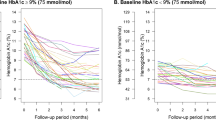Abstract
Subjects with type 2 diabetes are in a continuous catabolic state due to increased neoglycogensis during most of the fasting and the postprandial period. We compared the body cell mass index (BCMI) of 257 subjects with type 2 diabetes mellitus (T2DM) and 216 non-diabetic controls and found a statistically significant lower value in the diabetic subjects. This abnormality was reversed after 6 months of treatment with a diabetes-specific nutritional formula. Furthermore, in a population of 715 diabetic subjects without other diseases, we found that the BCMI was inversely correlated with the prevailing HbA1c and the duration of the disease.
Similar content being viewed by others
References
Revers RR et al (1984) Influence of hyperglycemia on insulin’s in vivo effects in type II diabetes. Clin Invest 73(3):664–672
Petersen KF (1996) Contribution of net hepatic glycogenolysis to glucose production during the early postprandial period. Am J Physiol Endocrinol Metab 270:E186–E191
Cunningham JP et al (1987) New approaches to the noninvasive assessment of body composition: bioelectrical impedance analysis and total body electrical conductivity. Nutr Inter 3(1)
Schloerb P et al (1986) Bioimpedance as a measure of total body water and body cell mass in surgical nutrition. Eur Surg Res 18(S1):3
Deuremberg P (1989) Body composition changes assessed by bioelectrical impedance measurements. Am J Clin Nutr 49(3):401–403
Piccoli A et al (1994) A new method for monitoring body fluid variation. Kidney Int 46(2):534–539
Robert S (1993) Bioelectrical impedance assessment of nutritional status in critically ill patients. Am J Clin Nutr 57:840–844
Segal KR (1988) Lean body mass estimation by bioelectrical impedance analysis: four site cross-validation study. Am J Clin Nutr 47:7–14
Moberg E (1993) Estimation of blood-glucose variability in patients with insulin-dependent diabetes mellitus. Scand J Clin Lab Invest 53(5):507–514
Tatti P et al (2007) Abstract: effect of a slow release formula (@Glucerna SR) on the risk of hypoglycemia and the blood glucose profile. Diabetes Technology Society Meeting, San Francisco, CA
Kovatchev BP et al (2002) Methods for quantifying self-monitoring blood glucose profiles exemplified by an examination of blood glucose patterns in patients with type 1 and type 2 diabetes. Diabetes Technol Ther 4:295–303
Pierson RN Jr et al (1974) Total-body potassium in health: effects of age, sex, height, and fat. Am J Physiol 226:206–212
Sternfeld B et al (2002) Associations of body composition with physical performance and self-reported functional limitation in elderly men and women. Am J Epidemiol 156:110–121
Engelhart M et al (1996) Weight reduction in obese patients with rheumatoid arthritis, with preservation of body cell mass and improvement of physical fitness. Clin Exp Rheumatol 14:289–293
Chumlea WC (2002) Body composition estimates from NHANES III bioelectrical impedance data. Int J Obes 26(12):1596
Shumei S (2003) Development of bioelectrical impedance analysis prediction equations for body composition with the use of a multicomponent model for use in epidemiologic surveys. Am J Clin Nutr 77:331–340
The Look Ahead Research Group (2007) Diabetes Care 30:1374–1387
Conflict of interest
Patrizio Tatti was an international speaker for the Abbott Co. No conflict of interest is reported for the remaining authors.
Author information
Authors and Affiliations
Corresponding author
About this article
Cite this article
Tatti, P., di Mauro, P., Neri, M. et al. Reduced body cell mass in type 2 diabetes mellitus: reversal with a diabetes-specific nutritional formula. Mediterr J Nutr Metab 3, 133–136 (2010). https://doi.org/10.1007/s12349-010-0004-0
Received:
Accepted:
Published:
Issue Date:
DOI: https://doi.org/10.1007/s12349-010-0004-0



